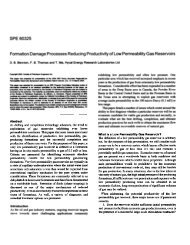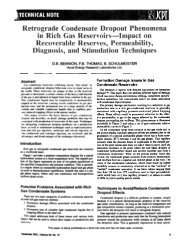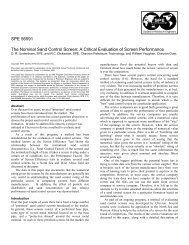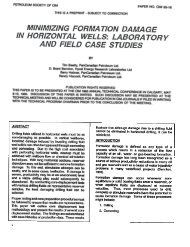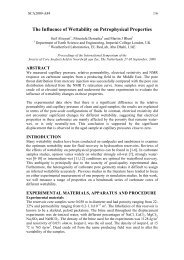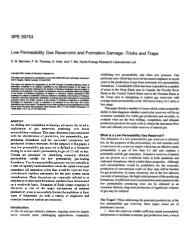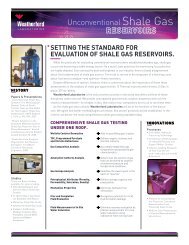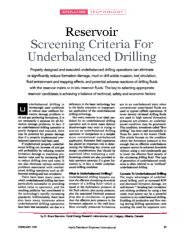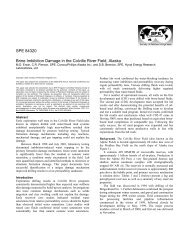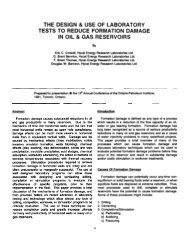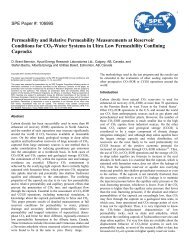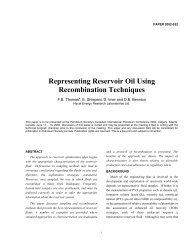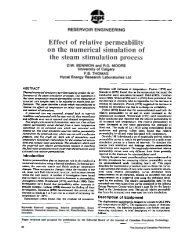Asphaltene Onset - Effects of Inhibitors - Weatherford Laboratories
Asphaltene Onset - Effects of Inhibitors - Weatherford Laboratories
Asphaltene Onset - Effects of Inhibitors - Weatherford Laboratories
You also want an ePaper? Increase the reach of your titles
YUMPU automatically turns print PDFs into web optimized ePapers that Google loves.
ASPHALTENE ONSET, EFFECTS OF INHffiITORSAND EOS MODELING OF SOLmS PRECIPITATION IN LIVE OILUSING ACOUSnC RESONANCE TECHNOLOGYA. Sivaraman, Y. Hu. A.K.M. Jamaluddjn, F .B. Thomas and D.B. BennionHycal Energy Research <strong>Laboratories</strong> Ltd.Calgary, Alberta, Canada T2E 6T6Key Words: Acoustic Resonance, <strong>Asphaltene</strong>, Bubble Point, InhibitorPrepared for presentation at the 1999 Spring National meeting, Houston, Texas, March 14-18Copyrights@A. Sivaraman, F.B. Thomas and D.B. BennionHycal Energy Research <strong>Laboratories</strong> Ltd., Calgary, Canada, January 1999, UnpublishedAIChE shall not be responsible for statements or opinions contained in papers or printed in the publications.
AbstractAcoustic Resonance Technology is a newly emerging tool for obtaining high quality data on asphaltene onset in very dark liveoil or dead oil at reservoir conditions. This mercury-free digital technology makes it possible to make fast highly accuratemeasurements during depressurization runs to identify the onset <strong>of</strong> asphaltene precipitation (solid-liquid equilibrium (SLE» andthe bubblepoint (vapor-liquid equilibrium (VLE» during the same run.Measurements were performed at temperatures from 71 0 C to 1160 C and at pressures from 9000 psia to 1200 psia. Comparison<strong>of</strong> the VLE data obtained from optical mediods showed excellent agreement. <strong>Effects</strong> <strong>of</strong> inhibitors on die solids precipitation onsethave been investigated and discussed. EOS modeling results have been presented widi comparisons. There is good agreementbetween measured data and dieory.IntroductionWax and asphaltene precipitation from reservoir fluids has been a common problem for many years. These solids remain indrops below onset conditions. Wax fonnation occurs when the reservoir fluid cools below the cloud point temperature'.<strong>Asphaltene</strong> precipitation occurs due to the instability caused in the colloidal suspension due to changes in pressure, temperatureor composition <strong>of</strong> the oil. <strong>Asphaltene</strong>s are classified by the particular solvent used to precipitate them2 3. Precipitation <strong>of</strong> waxesand asphaltenes poses severe operational problems during the life <strong>of</strong> producing wells in the subsurface, wellhead equipment inseparators and fa.nks4 s. Cleanup costs can be very high in <strong>of</strong>fshore oil production6.<strong>Asphaltene</strong> and wax precipitation can be deterDlined experimentally. Several techniques such as fluorescence spectromeny7,conductivity measurements., fibre optics9, light scattering techniqueslO and cross polarized microscopy" are used to determineincipient solids precipitation experimentally. For black oil, most <strong>of</strong> the techniques become inadequate. In the case <strong>of</strong>NIR, theproblems are due to alignment, poor signal to noise ratio and the dynamic range <strong>of</strong> operation is limited.An advanced acoustic resonance technology (ART) has been successfully tested at Hycal Energy Research <strong>Laboratories</strong> Ltd. toidentify solids precipitation onset conditions. The most powerful use <strong>of</strong> ART is to exploit the time evolution <strong>of</strong> the acousticresponse in fluids under variable and well-controlled conditions <strong>of</strong> pressure, volume and temperaturel2 13 14. It <strong>of</strong>fers a sensitiveand objective method for probing phase transitions. The color <strong>of</strong> the fluid has no impact on the technique's ability to identifyphase transition.Experimental DetailsThe acoustic resonance assembly at Hycal consists <strong>of</strong> a cylindrical resonator <strong>of</strong> 0.25 inches in diameter made <strong>of</strong>Hastelloy to resistcorrosion. The cylindrical cavity has two transducers: one at the top and the other at the bottom. The excitation <strong>of</strong> acousticstimulation is applied through the top piezo-electric transducer by applying a voltage through an excitation source. The acousticvibrations go through the fluids and the resultant vibrations are received by the receiver at the bottom <strong>of</strong> the resonator. Theacoustic response carries information <strong>of</strong> the fluids through the phase transition. Hence, by analyzing the acoustic responses, onecan detect the onset <strong>of</strong> liquid-solid or liquid-vapor transition in fluids.Pressure, volume or temperature can be changed with alacrity in order to analyze potential phase transition with anyone <strong>of</strong> theseindependent variables held constant. The assembly is housed in a well-insulated circulating air bath with precise temperaturecontrol from 1500 C to -400 C. A digital pressure gauge is used to measure pressures up to 10000 psia and a platinum resistancethermometer is used to precisely measure temperatures. A linear velocity displacement transducer is used to accurately measurethe volume at any instant <strong>of</strong> time. The acoustic response received by the receiver is processed through a low noise amplifier andthen through a fast analog to digital convertor (ADC). Acoustic data, at a sampling rate <strong>of</strong> 100 khz, acquired by the ADC issynchronized by a trigger signal generated by a function generator. The acquisition computer interfaced to the control computerdisplays the acoustic spectrum (frequency domain) through a graphic interface and shows the data. Pressure, temperature andvolume data gathered during acoustic data acquisition are also displayed. The froger print <strong>of</strong> the spectrum is the representation
<strong>of</strong> various excited modes <strong>of</strong> the fluid contained in the resonator. Custom s<strong>of</strong>tware has been used to track one <strong>of</strong> the modes alongwith temperature, pressure or volume and shows the liquid-solid or liquid-vapor transitions.The acoustic response in a fluid in a cylindrical resonator, can be represented by the resonance frequency and is related to sonicspeed by the following equation:fl nzlf= +2amn2a1/2Where C is the sonic speed in the fluid. Dz is an integer which defmes the modes (Dz = 1, flISt radial and Dz = 2, second radial, etc.),
Table 1.SetNo.ItemsPressure(psia)Temperature<strong>of</strong> (°C)160 (71) 190 (88) 210 (99) 220 (105) 230 (110) 240 (116)Live Oil Solids <strong>Onset</strong> 6855 6588 6419 6225Bubble Point 3221 3284 3276 32902 Live Oil + 200/0DeasphaltedOil1 Live Oil + 400/0DeasphaltedOil4 Live Oil + 20%Deasphalted Oil + 5000ppm <strong>of</strong> Inhibitor X.5 Live Oil + 20%Deasphalted Oil + 10000~~f!nhloitor XSolids <strong>Onset</strong> 7276 6886 6463 5798Bubble Point 1999 2368 2469 2660Solids <strong>Onset</strong> 6526 6026 S6875231Bubble Point 1812 2132 2324 2498Solids <strong>Onset</strong>7192 wsoS377Bubble Point 1963 2385 2630Solids <strong>Onset</strong> 4062 39323813Bubble Point 1566 2344 2586There have been several opinions about the effects <strong>of</strong> deasphalted oil on asphaltene precipitation onset pressures but no data hasbeen found. Recent AR data on live oil with 20% deasphalted oil and 40% deasphalted oil COnIJrDled the authors' view that thesecombinations strengthen the colloidal suspension and suppress the asphaltene precipitation onset pressures to some extent asshown in Table I. The solids onset pressure in live oil + 20% deasphalted oil dropped from 7276 psia at 71 °C to 5798 psia at116°C and the bubblepoint increased from 1999 psia at 71 °C to 2660 psia at 116°C respectively. The AR results for live oil +400/0 deasphalted oil indicated further reduction in solids onset from 6526 psia at 71 °C to 5237 psia at 116°C and a bubblepointincrease from 1812 psia at 71 °C to 2498 psia at 116°C. Further attempts were made with an Inhibitor X at Hycal with variousAR results at 5000 and 10000 ppm <strong>of</strong> Inhibitor X in live oil + 200/0 deasphalted oil are presented in Table 1. The resultsconfim1ed that at 10000 ppm levels, the solids precipitation onset dropped from 4062 psia at 71 °C to 3813 psia at 116°C (wellbelow the production pressure <strong>of</strong> 5000 psia), and increased the bubblepoint from 1566 psia at 71 °C to 2586 psia at 116°C.Preliminary results are promising. Figure 2 presents the comparison <strong>of</strong> the results presented in Table 1.ModelingA single solid component asphaltene model states that solid precipitation occurs when the fugacity <strong>of</strong> the solid component in theliquid phase is greater than the fugacity <strong>of</strong> the fluid <strong>of</strong> the component as a solid. For this model, the fIrSt data point (6855 psiaand 990 C) was chosen as the reference point The solid fugacity for this point was generated using the multiphase solid fugacityfunction <strong>of</strong> CMG's WlNPROP. The solid fugacity at this point was then set equal to the fugacity <strong>of</strong> the asphaltene componentin the liquid phase predicted by the equation <strong>of</strong> state. The fugacity <strong>of</strong> the solid phase, at other experimental conditions, were thencalculated from the following model.Vs"RT(PRPTP)...,CpaRtn(%)Tr3
wherefsVsPRc.-T,TnPTPAHris fugacity <strong>of</strong> solid (atm)is molar volume <strong>of</strong> solid (lit/mol)is pressure (atm)is gas constant (cal/mol oK)is heat capacity <strong>of</strong> solid (cal/mol-K)is reference temperature (K) and pressure (atm)is triple point temperature (K)is triple point pressure (atm)is the heat <strong>of</strong> fusion (cal/mol)The solid heat capacity and the heat <strong>of</strong> fusion were also tuned to match the other experimental data parameters. Table 2 presentsthe results <strong>of</strong> modeled data along with AR experimental data and deviations. As shown there was good agreement. Figure 2presents the comparison <strong>of</strong> results.Table 2. Comparison <strong>of</strong> E~erimental Solid <strong>Onset</strong> Pressur~~th EOS Modeled ResultsTemperature<strong>of</strong> (°C)20% Deaspbalted Oil 40./. Deasphalted Oil Live 011Experimental Modeled ./. Error Experiment Modeledal%ErrorExperimentalModeled%Error160 (71) 7276 7276 0 6526 6526 0190 (88) 6886 68SO 0.52 6026 6OSO 0.40210 (99) 6463 6500 0.57 5687 S1OO 0.23 68SS 6853 0220 (105) 6588 6590 0.03230 (110) 6419 6420 0.02240 (116) 5198 S800 0.03 5237 S2SO 0.25 6225 6300 1JConclusionsThe state-<strong>of</strong> -die-art advanced acoustic resonance technique is a useful tool to determine die asphaltene onset conditions for a liveor dead oil. It has been an ideal probe to study the effects <strong>of</strong> inhibitors on asphaltene precipitation. Solid-liquid equilibrium andModeling for future prediction <strong>of</strong> asphaltene precipitations can be achieved by incorporating high quality AR data.4
References1. Reid, RC., Prausnitz, J.M. and Sherwood, T.K., "The Properties <strong>of</strong> Gases and Liquids", 3rd Edition McGraw-Hill Book Co. (1977).2. Speight, J.G. "Studies on Bitumen Fractionation (A) by a Cryscopic Method (B) Effect <strong>of</strong> Solvent Type on<strong>Asphaltene</strong> Solubility", Infonnation Series ARC 84 (1979).3. Speight, J.G., Long, R.B. and Trawbridge, T.D., "Factors in Influencing the Separation <strong>of</strong> <strong>Asphaltene</strong>sfrom Heavy Petroleum Feed Stocks", Fuel 63 (1984).4. Shelton, J.L. and Yarborough. L., "Multiple Phase Behavior in Porous Media During CO2 or Rich GasFlooding",./: Pet. Tech. //71 (1977).s. Leontarites, K.J. and Mansoor, GA., "<strong>Asphaltene</strong> Deposition: A Survey <strong>of</strong>Field Experience and ResearchApproaches", J. <strong>of</strong> Petrol. Science & Engineering 1,229 (1988).6. Tuttle, R.N., "High Pour Point and <strong>Asphaltene</strong> Crude Oil Sand Condensates", JPT, 1192 (1983).7. Wehry, G.L. and Rogers, L.B., "Fluorescence and Phosphorescence <strong>of</strong> Organic Molecules" Fluorescenceand Phosphorescence Analysis, Edited by D.M. Hercules, Interscience Publications, N.Y. (1966).8. Nighswander, I.A., KaIra, H. and Majeed, A., "Effect <strong>of</strong> Low Molecular Weight Hydrocarbons on the<strong>Onset</strong> Concentration and Bulk Properties <strong>of</strong> <strong>Asphaltene</strong> at In-Situ Temperature and Pressure Conditions",Paper SSE presented at the AIChE meeting, March 28 (1993).9. Fortland, P., Anfindlsen, H. and Fadness, F .H., "Detection <strong>of</strong> <strong>Asphaltene</strong> Precipitation and AmountsPrecipitated by Measurement <strong>of</strong> Electrical Conductivity", Fluid Phase Equalibria, 82, 157 (1993).10. Fuhr, B.J., "Properties <strong>of</strong> <strong>Asphaltene</strong> from a Waxy Crude", Fuel, 70, 1293 (1991).11 Hammamj, A., "Paraffin Deposition from Crude Oils: Comparison <strong>of</strong> Laboratory Results to Field Data",Paper 38776, SPE meeting held in San Antonio, Texas, October 5-8 (1997).12. Sivaraman, A., et aI, "Acoustic Resonance: An Emerging Technology to Identify Wax and <strong>Asphaltene</strong>Precipitation <strong>Onset</strong> in Reservoir Fluids", Paper 97-96 presented at the 48th ATM <strong>of</strong> the Petroleum Societyin Calgary, Alberta, Canada, lune 8-11 (1997).13 Sivaraman, A., et a1, "Advanced Acoustic Resonance for Solids Problems: Meeting Challenges in the NewMillennium", Paper presented at the DeepStar <strong>Asphaltene</strong> Workshop held at Texaco EPill Facility,Houston, TX, October 22-23 (1998).14. Colgate, S.O., McGill, K.C., Sivaraman, A. and Tatro, D., "Acoustic Resonance Detennination <strong>of</strong> SonicSpeed and die Critical Point for a Typical Retrograde Gas Condensate", Fluid Phase Equilibria, 79, 231(1992).



